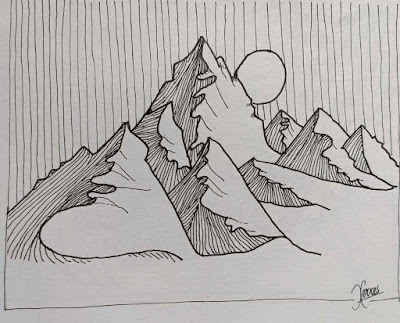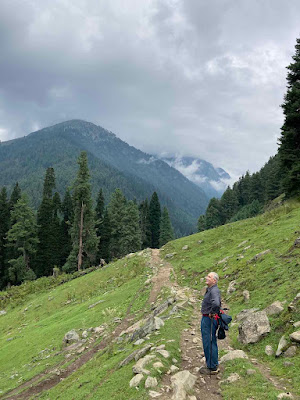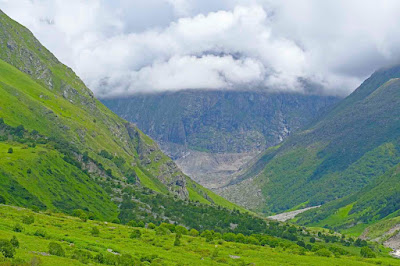"The world reveals itself to those who travel on foot" said Werner Herzog...
 |
| ...This is particularly true of the mountains, where beyond every bend in the track there is a new vista to enjoy. |
A friend, Basav, and I went to the Kashmir Valley, where we meandered our way to the Aru Valley. Down this Valley flows the Lidder River, not too wide, but very powerful especially since we had gone just after the monsoon.  |
| The gorgeous Lidder River |
As we approached the source of the river, the sides of the valley got steeper, the gorge got deeper and the river flowed more purposefully. It may have seemed placid, but as we looked carefully we could see the strong current. Seemingly little rivulets swept whole trees and boulders from the hillside. |
| Looking for the source of the Lidder River |
So Basav and I set out for Lidderwat, the source of the Lidder River, we had been told that it was about three hours each way, with an hour for lunch there made it about a seven hour return trip; given my slower pace, maybe about eight hours? We started walking at 8 am and expected to be back by 4 pm, we couldn't have been more wrong..jpg) |
Smiling and admiring the view when it was dry..... pic courtesy Basav
|
It was sunny and dry when we started out, though slushy in patches; we were told that it was always slushy at these places and that we needed to take a detour no problem, we walked around the slush. I had switched to a fanny pack for this hike, staying as light as possible for the long walk. Unfairly I shoved those 'last moment' things into Basav's rucksack. |
| The track was boggy at places, that's Basav laughing at the bog... |
The start was boggy and steep uphill, very steep; but only for about a kilometre, after that the terrain was lightly undulating all through, certain stretches remained very slushy, and the slush was deep enough to cover boots. Every bend in the track showed a different scene and the terrain was varied. The scenery changed from bald craggy mountains to mountainsides with pine trees right down to the river.
 |
Ranks of pine trees marching....
|
There were alpine meadows interspersed with deep, dark forests. Here the canopy was so dense that we couldn't see the sky and no light came down. There were bakarwals (goat and sheep herding nomadic tribes) that were preparing to go to lower altitudes for winter. They made tents of plastic sheets or rudimentary huts of mud and grass. |
| The track was steep and the trees were large age and old with Basav standing in front, he is not old but very tough. |
Two groups caught up to us, but then they would stop, so we overtook them again, then we would stop..... These groups stayed with us, leafrogging our way forward. They were going to camp the night at Lidderwat and we were to return and ominous portent of events to come.
.jpg) |
| ...and then it started raining. Thats a Bakerwal camp covered in plastic sheets at the bottom left. pic courtesy Basav. |
It rained heavily for a while, then it continued to drizzle intermittently. The drizzle made the complete track wet and muddy. Nothing (except Basav's shoes!) would keep us completely dry. .jpg) |
| ...gooey mud soon made our shoes weigh twice as much. pic courtesy Basav |
The path was mucky, our clothes and boots were muddy and so at after about six kilometres, at 1200 hours we (basav and I) took the decision to return. We had been walking for about four hours by then and had just asked the guide of one of the groups as to the distance to Lidderwat, he replied that it was about 10 km one way, so we had about four kilometres to go and 10 to return.  |
| ...the slushy parts now joined to become muddier and deeper. That's Basav having crossed the mud and not smiling so much any more. |
Before it rained, we were careful not to get our boots dirty, but the rain and exhaustion soon rid us of this notion and on the way back we were sloshing merrily through all but the deepest parts. Our hiking boots soon weighed more than the boots themselves. We ate packed lunch by the side of the track, admired the scenery and then continued walking. |
| A Bakerwal hut |
Mules and horses made the path muddier, often they would sink deep in the muck. The Bakerwals on the other hand found/made tracks on the hillside, often where none existed. These tracks were much easier to walk on, less boggy and our boots stayed cleaner. So we climbed higher up the hillside and followed these paths, finally coming down at the end.
|
| A welcome cup of noodles, maggi is the generic name for any noodles |
Having walked about 12 km, we were ravenous so we asked this gentleman to make us maggi-omlette, staple food in the mountains. To our surprise he didn't know what that was and served us maggi noodles and omlettes separately, hungry as were were we happily wolfed it down. And as always chasing this down with cups of Kahwa, the Kashmiri tea. |
I am glad we turned around when we did, another fourteen km would have had us thrashing about in the dark, though we both had head torches, the fun would have gone out of the hike. So it was a nice fun long walk. That we walked another couple of kilometres to the river on the other side.... but that is another tale.
"A rainy day is the perfect time for a walk in the woods" said an intrepid adventurer Rachel Carson. But the one that fits this situation the best is a quote by an unknown hiker "I'd rather be hiking in the rain, than sitting indoors at a desk on a sunny day" |









%20DSCF5555.jpg)














.jpg)



.jpg)
.jpg)



